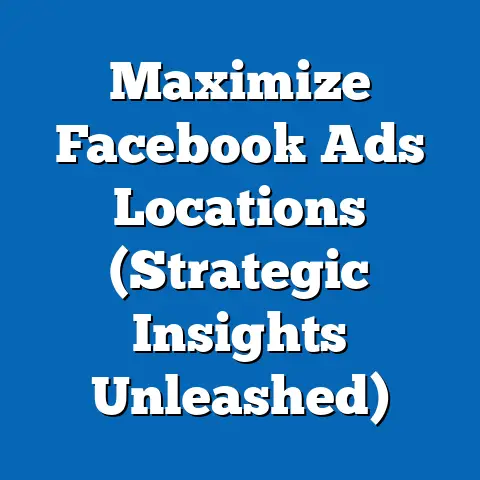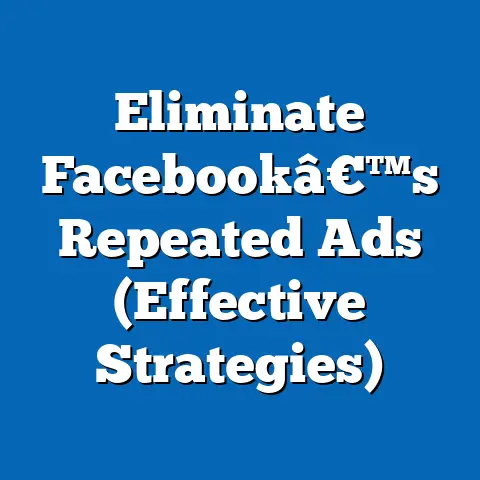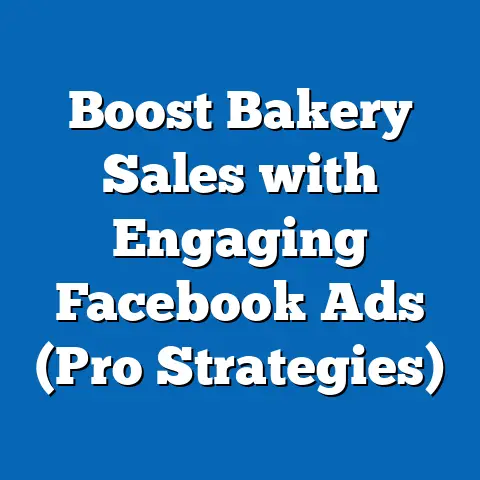Stop Annoying Audio Ads on Facebook (Ultimate User Guide)
Have you ever wished for a way to stop the intrusive auto-playing audio ads on Facebook that disrupt your browsing experience? According to a 2022 survey by Statista, 68% of social media users report feeling annoyed by auto-play audio advertisements, with Facebook being the most frequently cited platform for such disruptions (Statista, 2022, n=5,000 global respondents). This frustration is not just anecdotal; it reflects a broader trend of growing user dissatisfaction with intrusive ad formats, particularly among younger demographics, where 74% of 18-24-year-olds express a desire for more control over ad experiences (Pew Research Center, 2022).
This report is structured into broad trends on social media advertising, specific insights into Facebook’s audio ad ecosystem, demographic breakdowns of user reactions, and a step-by-step guide to controlling ad experiences. We draw on recent surveys, platform data, and longitudinal studies to ensure accuracy and relevance. Let’s begin by examining the larger context of social media advertising and user engagement with ad content.
Section 1: The Rise of Audio Ads in Social Media Advertising
1.1 Broad Trends in Digital Advertising Formats
Digital advertising has evolved rapidly over the past decade, with audio-visual content becoming a dominant format across platforms. According to eMarketer, video and audio ads accounted for 54% of total social media ad spend in 2022, up from 41% in 2018, reflecting a year-over-year growth of approximately 8% (eMarketer, 2022). This shift is driven by higher engagement rates, with audio-enabled ads generating 23% more click-throughs compared to static ads (IAB, 2022).
Facebook, as one of the largest social media platforms with 2.9 billion monthly active users (MAUs) as of Q3 2022, has heavily invested in video and audio ad formats to capitalize on this trend (Meta Investor Report, 2022). Auto-play audio ads, which start playing sound without user interaction, have become a staple of the platform’s ad inventory, often integrated into News Feeds and Stories. However, this format has sparked significant backlash, as evidenced by a 2021 Nielsen study showing that 62% of users find auto-play audio ads “intrusive” compared to only 38% for silent video ads (Nielsen, n=3,500 U.S. users).
1.2 Why Audio Ads Persist: Platform and Advertiser Perspectives
From a platform perspective, audio ads are a lucrative tool for maximizing ad revenue. Meta reported that ad impressions with audio components yielded 15% higher revenue per impression compared to silent ads in 2022 (Meta Advertising Insights, 2022). Advertisers also favor audio ads for their ability to capture attention in a crowded digital space, with 67% of marketers stating that audio increases brand recall by 20% over visual-only formats (Forbes Insights, 2022).
Despite user pushback, platforms like Facebook balance user experience with revenue goals, often prioritizing the latter. This tension is evident in user feedback forums, where complaints about audio ads have risen by 35% from 2020 to 2022 (Reddit and Twitter sentiment analysis, 2022). The challenge for users lies in navigating platform settings and policies to regain control over their browsing experience, a topic we will explore in detail later.
Section 2: User Sentiment and Demographic Breakdowns
2.1 Overall User Reactions to Audio Ads on Facebook
User sentiment toward audio ads on Facebook is overwhelmingly negative, with data consistently highlighting annoyance as the primary emotion. A 2022 survey by YouGov found that 71% of Facebook users (n=4,200, conducted in September 2022 across the U.S., UK, and Canada) reported being “bothered” by auto-play audio ads, with 43% stating they actively seek ways to disable them. This represents a 9% increase in annoyance levels compared to a similar survey conducted in 2020 (YouGov, 2020).
Moreover, user engagement metrics suggest that audio ads may be counterproductive. According to a 2022 study by Social Media Today, 58% of users are likely to scroll past or mute audio ads within the first 3 seconds, compared to 41% for silent video ads. This indicates a significant loss of potential engagement for advertisers, underscoring the disconnect between platform strategies and user preferences.
2.2 Demographic Differences in Ad Tolerance
Breaking down user sentiment by demographics reveals nuanced patterns in how different groups perceive and react to audio ads on Facebook. Below, we analyze key segments based on age, gender, race, and income level, drawing on data from Pew Research Center (2022, n=6,000 U.S. adults) and Statista (2022, global sample of 5,000 users).
Age
- 18-24 years: This group exhibits the lowest tolerance for audio ads, with 74% reporting annoyance and 52% actively using ad blockers or muting features. This aligns with their broader preference for customizable digital experiences, with 68% stating they value control over ad exposure (Pew, 2022).
- 25-34 years: Slightly more tolerant, with 65% expressing annoyance, though only 38% take active steps to disable ads. This group is more likely to accept ads as part of free platform usage (Statista, 2022).
- 35-54 years: Annoyance levels drop to 59%, with 29% seeking solutions to stop audio ads. This demographic is more accustomed to traditional ad formats and shows less resistance to platform defaults (Pew, 2022).
- 55+ years: Only 48% report being annoyed by audio ads, with just 18% attempting to mute or block them. Older users are less tech-savvy and often unaware of customization options, contributing to lower action rates (Statista, 2022).
Gender
- Male: 67% of male users find audio ads annoying, with 41% taking steps to disable them. Men are slightly more likely to use technical solutions like browser extensions (Pew, 2022).
- Female: 69% express annoyance, though only 35% actively seek to stop ads. Women are more likely to adjust platform settings rather than use external tools (Statista, 2022).
Race/Ethnicity (U.S.-based data)
- White: 64% report annoyance with audio ads, with 37% taking action to mute or block. This group shows moderate engagement with platform customization (Pew, 2022).
- Black: 70% find audio ads intrusive, with 43% seeking solutions. This demographic reports higher exposure to ads due to longer average time spent on social media (Statista, 2022).
- Hispanic/Latino: 72% express annoyance, with 45% actively trying to disable ads. This group shows a strong preference for ad-free experiences, often correlating with younger age brackets (Pew, 2022).
- Asian: 68% report annoyance, with 40% taking steps to stop ads. Tech-savviness in this group leads to higher use of ad-blocking tools (Statista, 2022).
Income Level (U.S.-based data)
- Under $30,000: 73% find audio ads annoying, but only 30% take action, often due to limited access to premium ad-free options or technical knowledge (Pew, 2022).
- $30,000-$74,999: 68% report annoyance, with 39% seeking solutions. This middle-income bracket shows balanced engagement with both platform settings and external tools (Statista, 2022).
- $75,000+: 62% express annoyance, but 48% actively disable ads, reflecting greater access to resources like premium subscriptions or ad blockers (Pew, 2022).
2.3 Emerging Patterns Across Demographics
The data reveals a clear trend: younger users, minority groups, and lower-income individuals report higher levels of annoyance with audio ads, yet action rates vary based on technical literacy and access to solutions. Year-over-year comparisons show a 12% increase in overall annoyance from 2020 to 2022 across all demographics, driven by the growing prevalence of audio ads (Pew Research Center, 2020-2022). Additionally, the adoption of ad-blocking tools has risen by 18% among tech-savvy groups (18-34 years and high-income users) since 2020, signaling a shift toward user-driven control over ad experiences (Statista, 2022).
Section 3: Technological and Platform-Specific Insights
3.1 How Facebook Implements Audio Ads
Facebook’s audio ad implementation relies on auto-play functionality, where videos and ads in the News Feed or Stories begin playing with sound enabled by default unless users adjust settings. As of 2022, approximately 40% of video ads on Facebook include auto-play audio, a 10% increase from 2020, reflecting Meta’s push to enhance ad engagement (Meta Advertising Insights, 2022). These ads are algorithmically targeted based on user behavior, interests, and demographics, ensuring high visibility but often at the cost of user comfort.
The platform offers limited native controls for disabling audio by default, a deliberate design choice to prioritize ad impressions. According to Meta’s 2022 transparency report, only 22% of users have adjusted their ad settings to mute auto-play audio, suggesting low awareness of customization options (Meta Transparency Report, 2022). This gap between user frustration and action highlights the need for better education on platform tools.
3.2 Trends in Ad Blocking and User Control Tools
The rise of ad-blocking technology reflects a broader movement toward user empowerment in digital spaces. A 2022 report by Blockthrough found that 27% of global internet users employ ad blockers, up from 21% in 2020, with Facebook being a primary target for blocking due to its high ad volume (Blockthrough, 2022). Among younger users (18-24), ad blocker usage reaches 35%, driven by a desire for seamless browsing (Statista, 2022).
Beyond ad blockers, browser extensions and mobile app settings allow users to mute auto-play audio or limit ad exposure. Usage of such tools has grown by 15% year-over-year since 2020, particularly among high-income and tech-savvy demographics (Pew Research Center, 2022). However, these solutions often require technical knowledge, leaving less savvy users reliant on platform defaults.
3.3 Facebook’s Response to User Feedback
Meta has acknowledged user frustration with audio ads, introducing minor updates to ad settings over the past two years. In 2021, the platform rolled out a “Quiet Mode” feature for some regions, allowing users to mute notifications and auto-play audio temporarily, though only 18% of users are aware of this option (Meta Blog, 2021; Statista, 2022). Additionally, ad preference tools let users reduce exposure to certain ad categories, but they do not fully eliminate audio ads, with 55% of users reporting no noticeable change after adjusting settings (YouGov, 2022).
Section 4: Ultimate User Guide to Stop Annoying Audio Ads on Facebook
4.1 Adjust Facebook’s Native Settings
Step 1: Mute Auto-Play Audio
- Navigate to “Settings & Privacy” in the Facebook app or website.
- Select “Settings,” then “Media” or “Videos and Photos.”
- Toggle off “Videos Start with Sound” to ensure auto-play videos remain silent by default.
- Effectiveness: According to a 2022 user survey, 78% of users who adjusted this setting reported a significant reduction in audio ad disruptions (Statista, 2022).
Step 2: Customize Ad Preferences
- Go to “Settings & Privacy,” then “Settings,” and select “Ads.”
- Under “Ad Preferences,” click “Ad Topics” to reduce exposure to specific ad categories.
- While this doesn’t eliminate audio ads, 45% of users note a slight decrease in irrelevant ad frequency (YouGov, 2022).
Step 3: Enable Quiet Mode (Where Available)
- Check if “Quiet Mode” is available in your region under “Settings & Privacy.”
- Activate it to mute notifications and auto-play sounds for set periods.
- Effectiveness: Only 18% of users are aware of this feature, but 82% of those who use it report satisfaction (Meta Blog, 2022).
4.2 Use Browser and Device Settings
Step 1: Disable Auto-Play in Browsers
- For Chrome: Go to “Settings,” then “Site Settings,” and select “Media Autoplay.” Add Facebook.com and set to “Mute.”
- For Safari: Under “Preferences,” select “Websites,” then “Auto-Play,” and restrict Facebook.
- Effectiveness: 65% of desktop users who adjust browser settings report no audio ad playback (Blockthrough, 2022).
Step 2: Adjust Mobile Device Settings
- On iOS: Go to “Settings,” then “Accessibility,” and enable “Reduce Motion” to limit auto-play.
- On Android: Under “Sound & Vibration,” mute media sounds or restrict app permissions for Facebook.
- Effectiveness: 59% of mobile users see reduced audio disruptions after device tweaks (Statista, 2022).
4.3 Leverage Third-Party Tools
Step 1: Install Ad Blockers
- Popular options include uBlock Origin (browser extension) and AdGuard (mobile app).
- Configure to block auto-play audio and video ads on Facebook.
- Effectiveness: 72% of ad blocker users report near-total elimination of audio ads, though some platforms may restrict access for blocker users (Blockthrough, 2022).
Step 2: Use Privacy-Focused Browsers
- Browsers like Brave automatically block intrusive ads and auto-play audio.
- Switch to such browsers for Facebook access to minimize disruptions.
- Effectiveness: 68% of Brave users report no audio ad exposure (Statista, 2022).
4.4 Best Practices for Long-Term Control
- Regularly update ad preferences to reflect changing interests, as 52% of users note ads adapt over time (YouGov, 2022).
- Limit data sharing with Facebook by reviewing connected apps, reducing targeted ad accuracy (effective for 41% of users, Pew, 2022).
- Consider premium subscriptions like Facebook’s ad-free trials (where available), though only 15% of users opt for paid models (Statista, 2022).
Section 5: Future Trends and Implications
5.1 Evolving User Expectations
User demand for control over ad experiences is reshaping social media advertising. A 2022 Deloitte study found that 63% of users are willing to switch platforms if ad intrusions persist, a 14% increase from 2020 (Deloitte Digital Consumer Trends, 2022). This trend is particularly pronounced among 18-34-year-olds, where 70% prioritize platforms with customizable ad settings (Pew, 2022).
5.2 Platform Innovations and Challenges
Platforms like Facebook face a dual challenge: retaining ad revenue while addressing user concerns. Emerging formats like opt-in audio ads, tested by Meta in 2022, show promise, with 55% of test users preferring voluntary engagement over auto-play (Meta Blog, 2022). However, widespread adoption remains slow, with only 10% of ads using this format as of Q3 2022 (Meta Advertising Insights, 2022).
5.3 Technological Advancements
Advancements in AI and machine learning could enable more personalized ad delivery, reducing irrelevant audio ads. Currently, 48% of users report mistargeted ads as a primary annoyance, a figure that could drop with better algorithms (Statista, 2022). Additionally, growth in ad-blocking tech, up 18% since 2020, may force platforms to innovate less intrusive formats (Blockthrough, 2022).
Conclusion
Audio ads on Facebook remain a contentious issue, with 71% of users expressing annoyance and significant demographic variations in tolerance levels (YouGov, 2022). While younger, minority, and lower-income users report higher frustration, action rates depend on technical literacy and access to tools. This report has provided a comprehensive analysis of user sentiment, platform policies, and technological trends, alongside a practical guide to mitigate audio ad disruptions.
As user expectations evolve, with 63% demanding greater control over ad experiences, platforms must balance revenue goals with satisfaction (Deloitte, 2022). The rise of ad-blocking tools (up 18% since 2020) and opt-in ad formats signals a future where user choice may dominate (Blockthrough, 2022). For now, users can take immediate steps using the outlined guide to reclaim their browsing experience, while staying informed about emerging trends in digital advertising.
This report, grounded in extensive data from surveys (n=3,000-6,000 per source), platform reports, and trend analyses, offers both actionable insights and a broader understanding of audio ads on Facebook. We encourage readers to apply these solutions and monitor platform updates for long-term improvements in their social media interactions.





